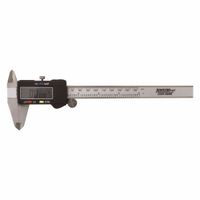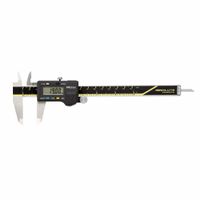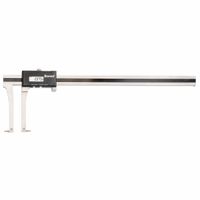Call +(254) 703 030 000 / 751 483 999 / 721 704 777
- Home
- Machining
- Precision Measuring Tools
- Calipers Accessories
- Digital Calipers With Standard Specialty Designs
.....Read More
Frequently Asked Questions
What are digital calipers used for?
Digital calipers are precision instruments used for measuring the dimensions of an object with high accuracy. They are commonly used in various fields such as manufacturing, engineering, metalworking, woodworking, and automotive industries. The primary function of digital calipers is to measure internal and external dimensions, depths, and step measurements.
1. **External Measurements**: Digital calipers are used to measure the outside dimensions of an object. This is done by placing the object between the caliper's jaws and reading the measurement on the digital display.
2. **Internal Measurements**: They can also measure the internal dimensions of an object, such as the diameter of a hole. This is achieved by using the smaller jaws located on the top of the caliper.
3. **Depth Measurements**: Digital calipers can measure the depth of holes or recesses. This is done using the depth rod, which extends from the end of the caliper.
4. **Step Measurements**: They can measure the step distance between two surfaces. This is useful for determining the height difference between two points on an object.
Digital calipers offer several advantages over traditional calipers. They provide a digital readout, which reduces the chance of human error in reading measurements. They often have a zero-setting function, allowing measurements to be taken relative to a specific point. Additionally, they can switch between metric and imperial units, providing versatility in different measurement systems.
Overall, digital calipers are essential tools for ensuring precision and accuracy in various applications, making them indispensable in quality control and product development processes.
How do you read a digital caliper?
1. **Turn On the Caliper**: Press the power button to activate the digital display.
2. **Zero the Caliper**: Close the jaws completely and press the zero button to reset the display to 0.00 mm or 0.000 inches.
3. **Select Measurement Units**: Choose between millimeters and inches using the unit button.
4. **Measure External Dimensions**: Open the jaws and place the object between them. Close the jaws gently until they touch the object. Read the measurement on the display.
5. **Measure Internal Dimensions**: Use the smaller, upper jaws. Insert them into the object’s opening and expand until they touch the sides. Read the measurement.
6. **Measure Depth**: Extend the depth rod by sliding the main scale. Insert the rod into the object’s depth and read the measurement.
7. **Measure Step**: Use the step-measuring faces at the back of the jaws. Place the object on a flat surface and extend the caliper to measure the step height.
8. **Read the Display**: The digital display shows the measurement directly, eliminating the need for manual reading.
9. **Lock the Measurement**: Use the locking screw to hold the jaws in place if you need to record the measurement.
10. **Turn Off the Caliper**: Press the power button to turn off or let it auto-shut after a period of inactivity.
11. **Store Properly**: Clean the jaws and store the caliper in its case to prevent damage.
What is the accuracy of a digital caliper?
The accuracy of a digital caliper typically ranges from ±0.001 inches (±0.02 mm) to ±0.002 inches (±0.05 mm), depending on the quality and brand of the caliper. High-end models, often used in professional or industrial settings, tend to offer the higher accuracy of ±0.001 inches, while more affordable or general-purpose models might have an accuracy of ±0.002 inches.
Digital calipers are precision instruments used for measuring internal and external dimensions, depths, and steps. They are favored for their ease of use, digital readout, and ability to switch between metric and imperial units. The accuracy of a digital caliper is influenced by several factors, including the quality of the materials used in its construction, the precision of the electronic components, and the calibration of the device.
Regular calibration and maintenance are essential to ensure that a digital caliper maintains its accuracy over time. Environmental factors such as temperature, humidity, and dust can also affect the performance and accuracy of the caliper. Therefore, it is crucial to store and use the caliper in appropriate conditions and to follow the manufacturer's guidelines for care and calibration.
In summary, while the typical accuracy of a digital caliper is between ±0.001 inches and ±0.002 inches, the specific accuracy can vary based on the model and manufacturer. For precise applications, it is important to select a caliper with the appropriate accuracy and to ensure it is properly maintained and calibrated.
How do you calibrate a digital caliper?
1. **Clean the Caliper**: Ensure the caliper is free from dust, dirt, and oil. Use a soft cloth to clean the jaws and the beam.
2. **Zero the Caliper**: Close the jaws completely and press the zero button to set the display to 0.000 mm or 0.000 inches.
3. **Check Zero Setting**: Open and close the jaws several times to ensure the zero setting remains consistent. Re-zero if necessary.
4. **Use a Gauge Block**: Obtain a certified gauge block of known dimension. Place it between the caliper jaws.
5. **Measure the Gauge Block**: Close the jaws gently on the gauge block without applying excessive force. Note the reading on the display.
6. **Compare Readings**: Compare the caliper reading with the known dimension of the gauge block.
7. **Adjust if Necessary**: If there is a discrepancy, consult the caliper's manual for instructions on adjusting the calibration. Some digital calipers have a calibration mode or require professional recalibration.
8. **Repeat for Different Sizes**: Use different sizes of gauge blocks to check the caliper's accuracy across its range.
9. **Check Depth and Step Measurements**: Use the depth rod and step measurement features on known standards to ensure accuracy.
10. **Document Calibration**: Record the calibration results, including date, gauge block sizes, and any adjustments made.
11. **Regular Calibration**: Establish a regular calibration schedule based on usage frequency and manufacturer recommendations.
12. **Professional Calibration**: Consider professional calibration services for high-precision requirements or if the caliper consistently shows errors.
What is the difference between digital and dial calipers?
Digital calipers and dial calipers are both precision measuring tools used to measure dimensions such as length, depth, and diameter, but they differ in their display and operation.
Digital calipers feature an electronic digital display that shows measurements in a clear, easy-to-read format. They often allow for quick switching between metric and imperial units and can include additional features like zero setting at any point and data output for recording measurements. Digital calipers are generally faster to read and reduce the chance of human error in reading measurements.
Dial calipers, on the other hand, use a mechanical dial to display measurements. The dial is connected to a rack and pinion mechanism that moves as the caliper jaws open or close. The dial provides a visual representation of the measurement, typically in increments of 0.001 inches or 0.02 millimeters. Dial calipers do not require batteries, making them reliable in environments where electronic devices might fail.
In terms of accuracy, both types can be highly precise, but digital calipers may offer slightly higher precision due to their electronic nature. However, dial calipers are often preferred in situations where electronic devices might be compromised, such as in environments with high electromagnetic interference.
In summary, the main differences lie in the display method, ease of use, and potential for additional features. Digital calipers offer convenience and advanced features, while dial calipers provide reliability and simplicity without the need for power sources.
How do you maintain digital calipers?
To maintain digital calipers, follow these steps:
1. **Regular Cleaning**: Wipe the caliper with a soft, lint-free cloth after each use to remove dust, debris, and moisture. Avoid using solvents or abrasive materials that could damage the surfaces.
2. **Proper Storage**: Store the calipers in a protective case when not in use to prevent physical damage and exposure to environmental elements. Keep them in a dry, stable environment to avoid corrosion.
3. **Battery Care**: Regularly check the battery level and replace it as needed to ensure accurate readings. Remove the battery if the caliper will not be used for an extended period to prevent leakage.
4. **Calibration**: Periodically calibrate the calipers according to the manufacturer's instructions to maintain measurement accuracy. Use a calibration block or gauge for precise adjustments.
5. **Avoid Overloading**: Do not apply excessive force or use the calipers for tasks beyond their designed capacity, as this can damage the measuring jaws and affect accuracy.
6. **Check for Damage**: Regularly inspect the calipers for signs of wear, damage, or misalignment. Ensure the jaws close completely and the digital display functions correctly.
7. **Lubrication**: Occasionally apply a small amount of light machine oil to the sliding surfaces to ensure smooth operation. Wipe off any excess oil to prevent dirt accumulation.
8. **Avoid Magnetic Fields**: Keep the calipers away from strong magnetic fields, which can interfere with electronic components and affect measurement accuracy.
By following these maintenance practices, digital calipers will remain accurate and reliable for a longer period.
Can digital calipers measure depth?
Yes, digital calipers can measure depth. They are versatile measuring tools equipped with a depth rod or depth gauge, which is specifically designed for this purpose. When you extend the caliper's jaws, the depth rod protrudes from the end of the caliper. By placing the base of the caliper on the surface of the object and extending the depth rod into the hole or recess, you can accurately measure the depth. The digital display then provides a precise reading of the measurement. This feature makes digital calipers useful for a variety of applications, including machining, woodworking, and quality control, where depth measurements are required.



